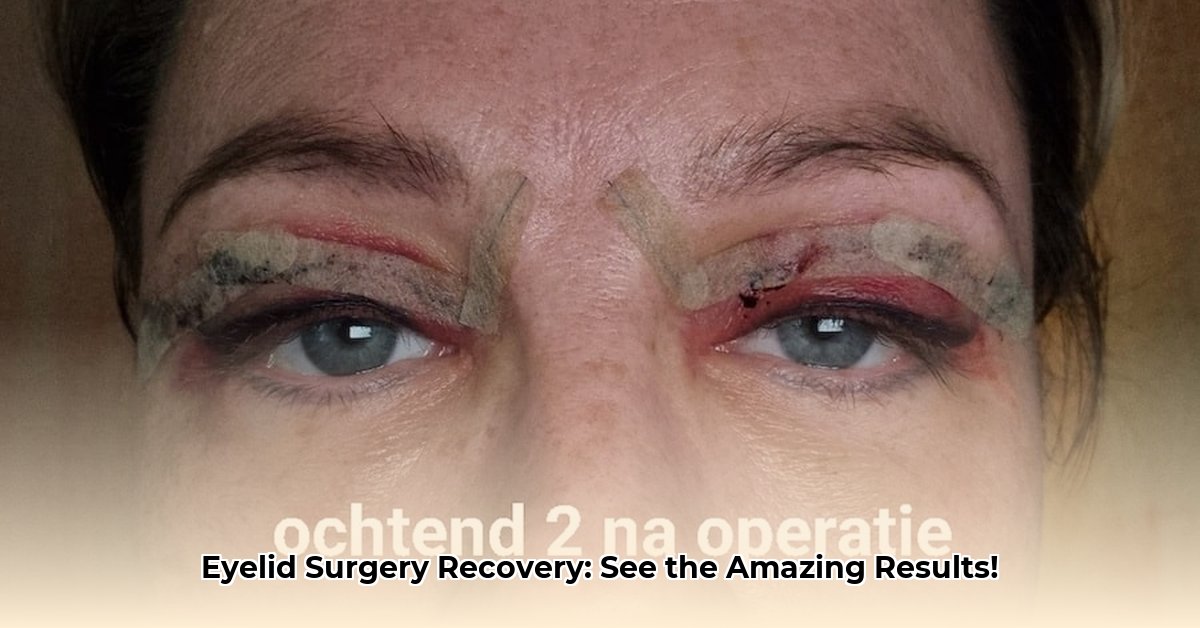“`markdown
See Your Day-by-Day Eyelid Surgery Recovery: Photos & Expert Guide
Thinking about getting eyelid surgery? Knowing what to expect afterward is super important. This guide uses photos and expert advice to show you exactly what your recovery from blepharoplasty might look like, day by day. We’ll cover everything from the initial swelling and bruising to the final healing stages, giving you tips to manage discomfort and speed up the process. You’ll see real photos, learn how to reduce swelling and bruising, and get answers to common questions about scarring. For driving restrictions after eye surgery, check out this helpful guide on driving with dilated eyes. This easy-to-follow guide will help you feel confident and prepared for your recovery, so you can focus on getting back to your normal life. Let’s get started!
Day by Day Eyelid Surgery Recovery Time Photos: Your Visual Guide to Healing
Getting eyelid surgery? It’s a big decision, and you probably have lots of questions, especially about what to expect afterward. This guide uses real photos to show you a typical recovery timeline, along with simple tips to help you feel prepared and confident. Remember, everyone heals differently, so this is just a general idea. Your surgeon’s advice is always the most important. Expect to gain a better understanding of the blepharoplasty journey.
The First Few Days: Navigating the Initial Stages of Eyelid Surgery Recovery
Those first 72 hours after surgery are often the most intense. You’ll likely experience some swelling and bruising – think of it like a minor injury; it’s your body’s natural response. Day-by-day photos really highlight this initial swelling, particularly noticeable on days one, two, and three. Don’t worry, it’s normal! Here’s what you can do to manage the immediate post-operative symptoms:
-
Ice, Ice, Baby: Apply cold compresses frequently to reduce the swelling. Think 15-20 minutes on, then 15-20 minutes off. Repeat throughout the day.
-
Head Elevation: Sleep with your head propped up on extra pillows. Gravity is your friend here – it helps minimize swelling.
-
Gently Does It: Follow your surgeon’s instructions carefully for cleaning the incisions. Keep them clean and dry to prevent infection. Your surgeon will likely advise you to use specific solutions or a gentle cleanser. The meticulous incision care contributes to a successful recovery!
-
Medication Adherence: Take all prescribed medications, including pain relievers and antibiotics, as directed by your surgeon. Don’t skip doses, and be sure to understand the purpose of each medication.
-
Limit Screen Time: Reduce exposure to screens (phones, tablets, computers) to minimize eye strain and dryness.
Days 4-7: Seeing the Light at the End of the Tunnel After Your Blepharoplasty Procedure
By day four, you’ll probably notice a significant improvement. The swelling starts to go down. The bruising might still be visible, but it will be much less intense. You might feel more comfortable and less restricted in your daily movements. The photos for this period show a clear transition, a definite reduction in inflammation. You will feel a renewed sense of hope as the intense side effects diminish.
-
Keep Icing: You might not need to ice as often now, but continue as suggested by your doctor.
-
Light Activities: Start doing some light tasks around the house, but avoid strenuous activities. Listen to your body – if something feels too difficult, rest.
-
Watch for Trouble: Keep an eye out for any signs of infection, such as increasing redness, pain, or pus around the incisions. If you notice anything unusual, contact your surgeon immediately.
-
Eye Lubrication: Use artificial tears or lubricating eye drops as recommended by your surgeon to combat dryness and irritation.
-
Sunglasses Indoors: If you’re experiencing light sensitivity, wear sunglasses even indoors.
Weeks 2-4: Getting Back to Yourself After Eyelid Surgery
As you move into the second and third weeks, the swelling continues to decrease. Many people can return to work and their normal activities during this phase. The bruising should be mostly gone. You might notice some mild swelling or slight discoloration remaining, but you’ll be feeling much better. The photos around this time usually show most of the healing complete.
-
Makeup (Maybe): Your surgeon will let you know when it’s okay to use light makeup to cover up any remaining discoloration.
-
Sun’s Out, Protection’s On: Protecting your skin from the sun is super important. Use a sunscreen with an SPF of 30 or higher – this helps prevent hyperpigmentation (dark spots).
-
Follow-Up Appointments: It’s essential to attend all your scheduled post-operative check-ups. Your surgeon will monitor your progress and address any concerns.
-
Contact Lenses: If you wear contact lenses, ask your surgeon when it will be safe to resume wearing them.
-
Hydration and Nutrition: Maintain a healthy diet and stay well-hydrated to support the healing process.
Beyond Four Weeks: The Road to Full Recovery After Blepharoplasty
After a month, you should be well on your way to a full recovery. Though, it could take up to three months for all the swelling and any leftover bruising to completely disappear. During this later phase, focus shifts to long-term care. It will require lifestyle adjustments to sustain your results.
-
Scar Care: Your doctor might recommend silicone scar sheets or gels to help minimize the appearance of scars.
-
Sun Protection: The Long Game: Keep up the sun protection for many months to come, as this is crucial for long-term results.
-
Ongoing Monitoring: Keep a close eye on your eyelids for several weeks after the surgery and contact your doctor immediately if any concerns arise.
-
Gentle Massage: If your surgeon approves, gently massage the incision areas to help break up scar tissue and improve flexibility.
-
Patience is Key: Remember that individual healing rates vary, so be patient with yourself and allow your body the time it needs to fully recover.
Your Eyelid Surgery Recovery: A Snapshot of Potential Complications
Remember, this is a general guideline. Recovery times vary depending on individual factors. This table summarizes potential complications, but remember, these are uncommon.
| Complication | Description | Likelihood (General Estimate) | Severity (Potential Impact) |
|---|---|---|---|
| Infection | Signs of infection (redness, swelling, pus) | Low | High |
| Hematoma | Collection of blood under the skin | Low | Medium |
| Dry Eye Syndrome | Dryness, irritation, and discomfort in the eyes | Medium | Medium |
| Excessive Scarring | Prominent, noticeable scars | Low to Medium | Low to Medium |
| Ptosis (Drooping Eyelid) | Eyelid sagging post-surgery | Low | Medium |
| Ectropion (Eyelid pulls away from eye) | Lower eyelid turning outward | Very Low | Medium |
| Temporary Blurred Vision | Temporary difficulty focusing | Medium | Low |
These day-by-day eyelid surgery recovery time photos and information are for general knowledge only. Always consult your surgeon for personalized advice. Your experience will be unique to you. But remember, careful post-operative care greatly enhances your healing.
How to Minimize Blepharoplasty Eyelid Surgery Scarring and Optimize Healing
Key Takeaways:
- Minimizing scarring after lower eyelid blepharoplasty is a team effort involving surgeon skill and diligent post-operative care.
- Pre-operative preparation, such as proper skin hydration and sun avoidance, sets the stage for better healing.
- Meticulous post-operative care, including keeping incisions clean and dry, significantly impacts scar visibility.
- Utilizing prescribed ointments and creams, along with cold compresses, helps reduce swelling and bruising.
- Realistic expectations are key; individual healing responses vary.
- Long-term scar management might include additional treatments like laser therapy or microneedling.
Understanding Your Scars: A Day-by-Day Journey Towards Scar Reduction After Blepharoplasty
Let’s embark on a visual journey—a day-by-day photographic guide to your lower eyelid blepharoplasty recovery. This isn’t just a series of pictures; it’s your roadmap to understanding what to expect and how to actively participate in how to minimize blepharoplasty eyelid surgery scarring. Understanding the stages will help you actively manage your healing.
Remember: every person’s healing journey is unique. Think of it like a fingerprint—distinct and individual. But the underlying principles remain the same. The body’s healing process is complex.
Day 1-3: Expect some swelling, bruising, and perhaps slight discomfort. Ice packs are your best friend during these initial days. Keep them handy! This helps reduce inflammation. Follow your surgeon’s instructions regarding pain medication. Your eyelids will feel tight. Maintaining an open line of communication with your surgeon is important.
Day 4-7: The swelling will gradually decrease. The bruising might start to fade. Gentle cleansing is crucial. Your doctor will provide detailed instructions; follow them precisely. This is about preventing infection, not just making things
- Mini Bento Boxes For Packing Kids Snacks And Small Meals - December 27, 2025
- Small Bento Box Makes Packing Lunch Easy and Fun Again - December 26, 2025
- Adult Bento Box Lunch Ideas For Quick Healthy Portable Options - December 25, 2025










